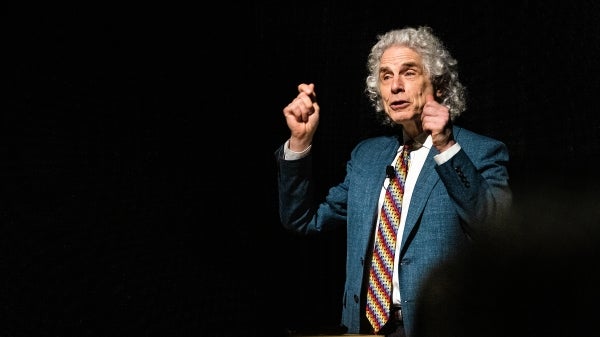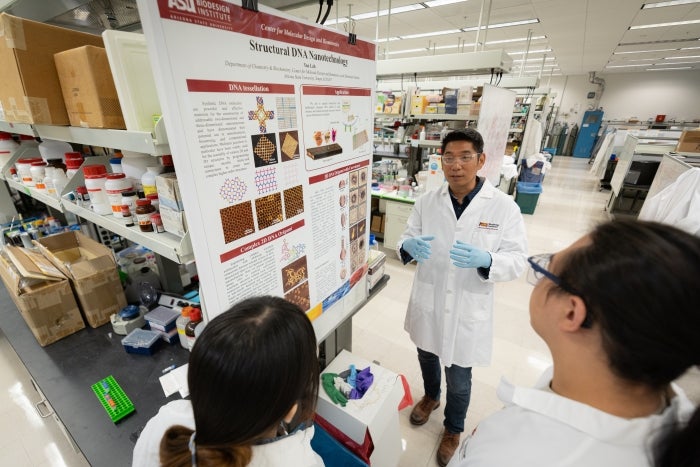Professor's expertise in DNA nanotechnology leads to top faculty honor

Hao Yan, director of the Biodesign Center for Molecular Design and Biomimetics at ASU and an expert in DNA nanotechnology, has been named a 2025 Regents Professor. Photo courtesy of Academic Enterprise Communications
Arizona State University Professor Hao Yan works at the cutting edge of DNA nanotechnology, designing molecular building blocks to create complex systems.
“I consider myself a biomolecular designer, a programmer and an engineer,” said Yan, a professor in the School of Molecular Sciences.
“I take inspiration from nature, which has a lot of molecular machines that can analyze functions and make a living system. And we take those capabilities and build molecular machines, molecular robotics and devices using nature's building blocks like DNA, RNA or proteins.”
He is director of the Biodesign Center for Molecular Design and Biomimetics and his research team was the first to successfully construct closed 3D DNA nanoforms — considered a linchpin for creating nanobots.
Yan is so excellent in his field that he has been named one of three ASU Regents Professors for 2025 — the highest faculty honor, which is achieved by only 3% of faculty members.
Yan has established the Biodesign Center for Molecular Design and Biomimetics as a leader in creating biomedical, energy-related and other technological innovations through the use of self-assembling molecules and materials.
Joshua LaBaer, executive director of the Biodesign Institute, said: “Hao is one of those unique individuals who is simultaneously brilliant and creative.
“His mind converts molecular sequences into three-dimensional structures and his creativity invents powerful applications for these tools. We are so fortunate to have such a talented professor in our team.”
But it almost didn’t happen. Just as his career was getting started, Yan considered leaving science behind to work on Wall Street.
Yan, who is from China and majored in chemistry at Shandong University, was working on his PhD at New York University in the early 2000s with his mentor, N.C. Seeman, known for inventing the field of DNA nanotechnology.
“His vision of building a designer crystal using DNA really was fascinating. So I joined his lab and I was able to publish a few good papers. That was very encouraging,” Yan said.
NYU was very close to the financial district and Wall Street. Yan saw the stock market reaching record heights and started teaching himself computer science.
“I was thinking that it is not easy to find an academic job, so I almost went to Wall Street to become a financial analyst. A lot of money, right?” he said with a laugh.
But then the stock market plummeted, the financial analyst jobs dried up and Yan stayed with chemistry. He was hired as a research assistant professor at Duke University, where he attracted nearly $1 million in federal grants in his three years there.
“That period was very productive for me because I could try out my own ideas, and that boosted my confidence,” Yan said.
By then it was 2004 and the Biodesign Institute had just opened at ASU. It was the perfect fit for Yan for two reasons.
“First is the topic. I was attracted by the concept for biodesign. I'm using DNA as a designing material. It’s no-brainer for me to come here.
“Second is the new building. I was one of the first labs in the building,” he said.
By 2008, Yan had been fast-tracked to full professor, and in 2012, he was honored as the inaugural Milton D. Glick Distinguished Chair of Chemistry and Biochemistry, named for the late chemistry professor Milton Glick, who served as provost and executive vice president at ASU.
Yan pitched his idea for a new center dedicated to DNA nanotechnology in 2013, and the Biodesign Center for Molecular Design and Biomimetics was launched.
“We want one day to build an autonomous nanobot that can go into the body and seek and destroy tumors and other diseases. That's the grand vision of what we want to do,” he said.
“We've shown that this nanobot works beautifully in a mice model that can shrink the tumor. And we've also developed a nanobot that can boost immunity and serve as a cancer vaccine.”
But clinical usage is years away.
“We're trying to push this with commercial partners to spin out companies,” he said.
“You really need the industry to drive the translation of fundamental scientific discovery into the clinical application.”
The field requires transdisciplinary collaboration, another reason why ASU is the perfect fit for Yan.
“I collaborate with a lot of people in physics, electrical engineering, material science, biomedical engineering, biology and also clinicians to try to engineer the modular system,” he said.
In addition, Yan still teaches undergraduates, which he enjoys.
“I like to share my personal story with them, my journey, my career, my frustrations,” he said.
He tells them that when he was a grad student, he was working 18-hour days, shuttling experiments between NYU in Manhattan and the Brookhaven National Laboratory in Long Island, and working with multiple primary investigators. One day, he lost several days’ worth of experiments.
“I think that really trained me in persistence,” he said.
He’s especially happy about the success of his former students. More than 30 have gone on to become faculty members around the U.S. and the world.
“We are very proud of what we produce. You see your students becoming great scientists that can exponentially amplify the impact and educate more people,” he said.
“I always tell my students, ‘My success is your success, and your success is my success.’”
More Science and technology

Popular science author Steven Pinker explores rationale behind irrational thinking at ASU event
Popular science author Steven Pinker returned to Arizona State University’s Tempe campus on Feb. 7 for a rational talk about irrational thinking.More than 200 people filled Marston Exploration…

Water expert drinks in ASU Regents Professor recognition
Hurricanes helped shape Amber Wutich's childhood.Growing up in Miami, she was no stranger to their whirling winds and water. These wild storms would eventually inspire her work with water…

How a childhood passion led Jim Bell to being named an ASU Regents Professor
In the early 1970s, in a rural town in the smallest state in the U.S., a young boy in elementary school began to imagine the wonders of space travel.Jim Bell sat in the living room of his family’s…
